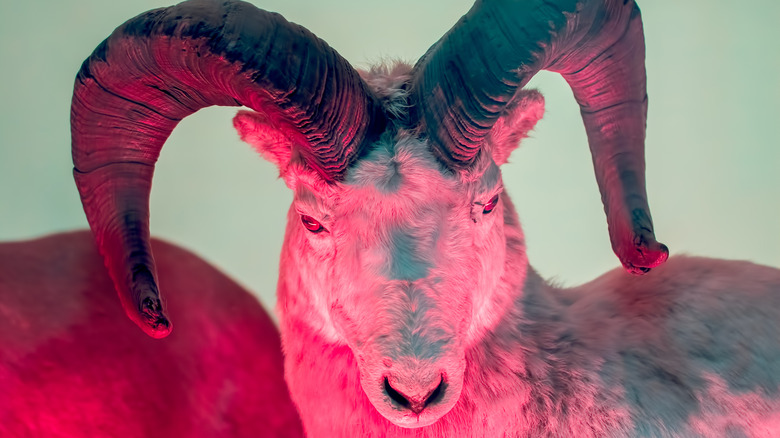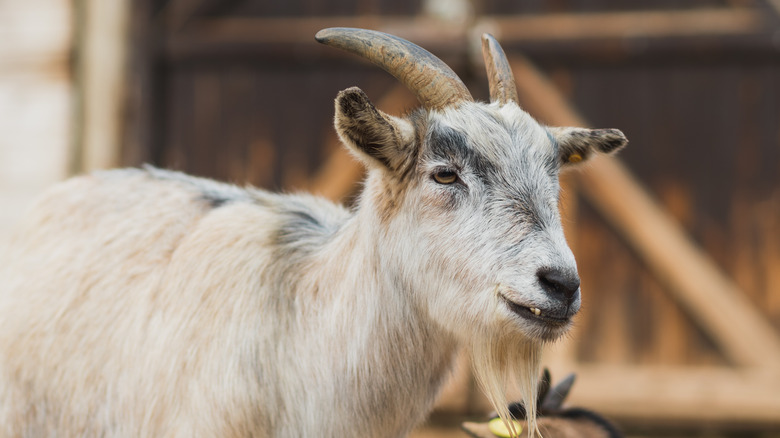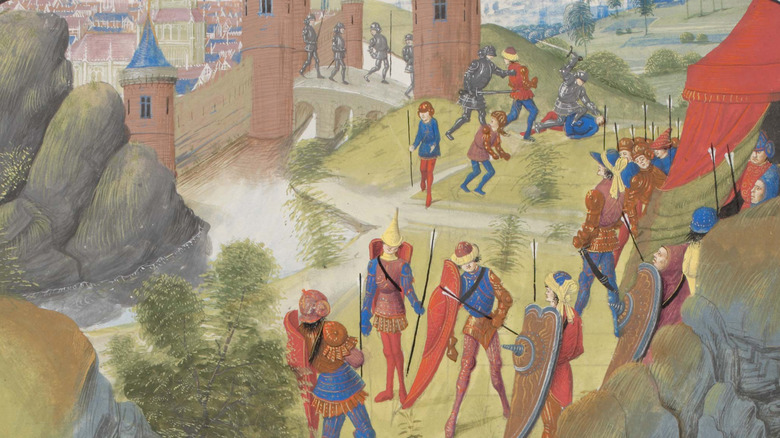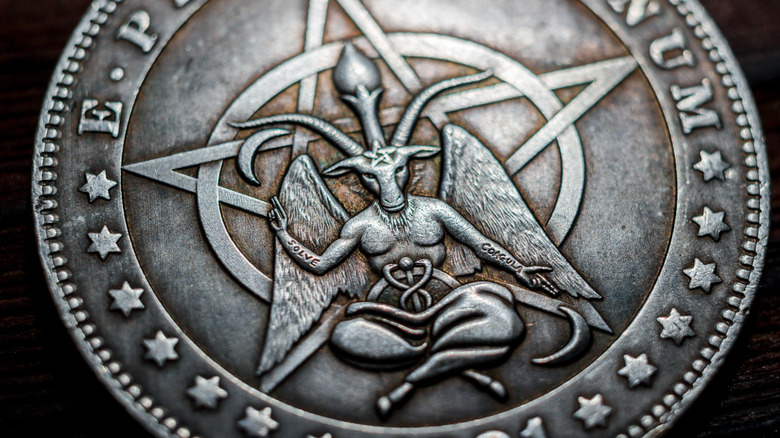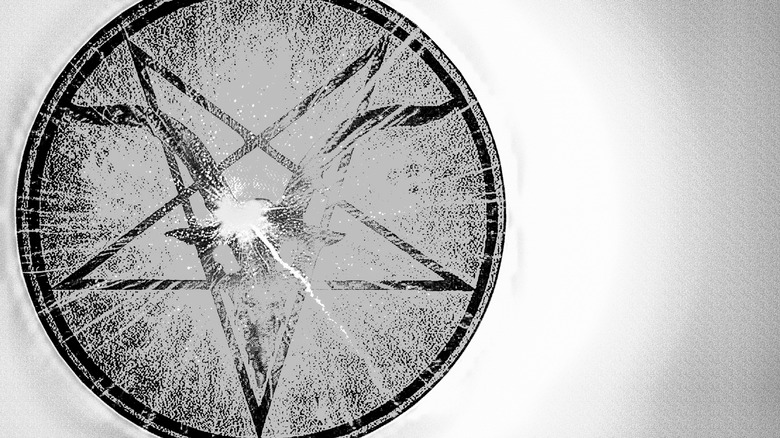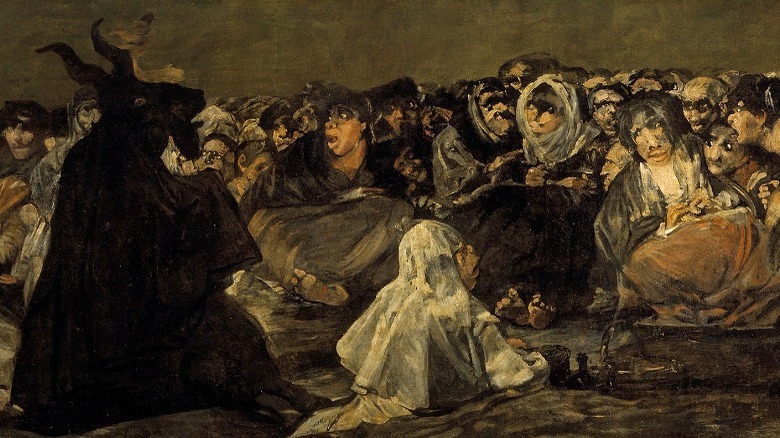Why Are Goats Synonymous With Satan?
The stunning about-face in public perception that goats have managed to pull off in recent years can not be understated. Today, goats are synonymous with athletic prowess. Not because of the sure-footedness put on display by mountain goats, but because the acronym G.O.A.T. stands for "Greatest Of All-Time" a name bestowed upon once-in-a-generation talents like Tom Brady, Michael Jordan, and Wayne Gretzky. People can't get enough of goats — they'll even line up just to knock out some yoga poses in their presence.
The reason goats should be a case study in public relations courses at universities around the globe is that this new image of goats has become the predominant view of the species. Now, when people hear "goat" the first person they think of is Tom Brady when for centuries the first person they thought of was Satan. What a reputation 180 that is (unless, you're a fan of the Indianapolis Colts, in which case, they may be one and the same, per ESPN). At best, goats were thought of as nature's trash cans.
Goats and Satan have gone hand and hoof for a long time, and the image of a goat in a satanic context has been seen in literature, art, and heavy metal concert T-shirts the world over. However, the question remains, how exactly did goats become synonymous with Satan in the first place?
Goats in the Bible
Logically the first place to check when trying to figure out why goats are so associated with Satan would be to consult the Bible itself. According to Bible Tools, goats are known for several traits including stubbornness, singleness of purpose, and leadership, which don't sound too bad, but those same traits are associated with people who may put their goals above others.
This is frowned upon in parts of the Bible, namely Matthew 25:33 in a metaphor about Jesus selecting good people over bad, with sheep representing good people and goats representing bad. In the same set of verses, sheep — the good people — are given eternal life, while goats are sent to the Lake of Fire, i.e. Hell. It's not a great look for goats, and it's easy to see how the entire goat population was stigmatized in the eyes of Christians.
In another part of the Bible, Titus 1:10-16 seems to indicate that goats need to be kept away from sheep out of fear of the influence they could have on the wooly livestock. Once, again it's not hard to see why the perception of the humble goat was taking a substantial hit, even before goats were fully associated with Satan.
The Templars and Baphomet
One of the earliest instances of a goat headed-deity came about long after the Bible was completed when the Poor Knights of Christ and of the Temple of Solomon — also known as the Knights Templar — were accused of worshipping an idol named Baphomet in 1307, per Brittanica. The Knights Templar were a group of knights who were active during the Crusades and their original duty was to protect Christan pilgrims. As time went on they started to become more of a military force.
In 1098, a crusader named Anselm of Ribemont wrote a letter describing the Siege of Antioch in modern-day Turkey, a battle between crusaders and Muslims that occurred at the start of the First Crusade. In the letter, Anselm stated that the Muslims "called loudly upon Baphomet." It wasn't clear what he meant by the word "Baphomet" but today scholars think he used an incorrect version of the French word "Mahomet" which was used to refer to Muhammad, the founder and prophet of Islam.
A few hundred years later, the Templars found themselves in a Baphomet-related bind. France's Philip IV ordered the arrest of all Templars and accused them of worshipping Baphomet as an idol and accusing the group of blasphemy out of fear that Baphomet was a demon that sought human sacrifices (via Refinery 29). According to History, accused Templars reportedly confessed to worshipping idols that included mummified heads, and some were even said to have used the word Baphomet, but the validity of those confessions has been questioned as time has progressed.
Éliphas Lévi drew the Sabbatic Goat
Hundreds of years after Philip IV tried to round up all the Templars for tipping their caps to Baphomet, the version of the deity that most people picture came to be. Éliphas Lévi was a French Magician and occultist who drew a winged man with a goat's head to use in his 1861 book "Dogme et ritual de la haute magie" or "Transcendental Magic: Its Doctrine and Ritual." The image appeared as the book's frontispiece — an image that typically sits opposite of a book's title page, per Meriam-Webster — and it became known as the "Sabbatic Goat."
According to Refinery 29, this drawing was a combination of numerous inspirations including the version of Baphomet the Templars were accused of worshipping, as well as the Devil tarot card, and the goat-headed Egyptian god Banebdjedet, with a splash of witchcraft influence for good measure. Lévi referred to his creation in all kinds of colorful ways in addition to the Sabbatic Goat, including "the fantastic monster," "the nightmare," and "that phantom of all terrors."
The Church of Satan adopted the Sabbatic Goat as a sigil
In the 1960s a new group was born out of that era's counterculture and its name and themes were sure to turn heads. A former carnival worker named Howard Stanton Levey decided to form own his church. The man is better known by the name Anton Szandor LaVey, and his church is best known as the Church of Satan, per Britannica. The Church of Satan only amassed about 2,000 followers but it managed to stay in the public consciousness thanks to LaVey's TV appearances and several celebrities — namely Jayne Mansfield and Sammy Davis Jr., who were known to associate with the church.
LaVey introduced the Sigil of Baphomet as the church's official insignia which featured a combination of a goat's head inside of a pentagram. A sigil is a symbol, sign, or word that plays a role in occult disciplines like astrology and magic, per Merriam Webster. According to the Church of Satan, this is what cemented the association between goats and Satan as the sigil transcended the church and became a generally accepted symbol for the Devil.
Paganism and witchcraft
Some have argued other reasons that goats are associated with Satan. According to Refinery29, one guess has to do with similarities in appearance between Christianity's version of the Devil and the Greek deity, Pan. The idea is that Christians tried to make Pagan beliefs look bad by drawing comparisons between the two deities, as both are typically depicted as having goat-like hooves and horns.
Witchcraft has also been a frequent link between goats and Satan and that association continues to this day. A more recent example can be seen in the 2015 film "The Witch." The movie features a goat known as Black Philip that is central to the story and even implied to be the Devil himself. According to Slate, the film ends with a title card stating that the events depicted came from 17th-century journals from the Salem, Massachusetts area, however experts have indicated there are no accounts that mention goats in this way, however, some do mention a pair of dogs that were killed out of fear that they were witches.
The film's director Robert Eggers has since acknowledged that Black Philip was more or less his own creation though he drew inspiration from folklore and artwork like Francisco Goya's "Witches' Sabbath (The Great He-Goat)," per Atlas Obscura.
